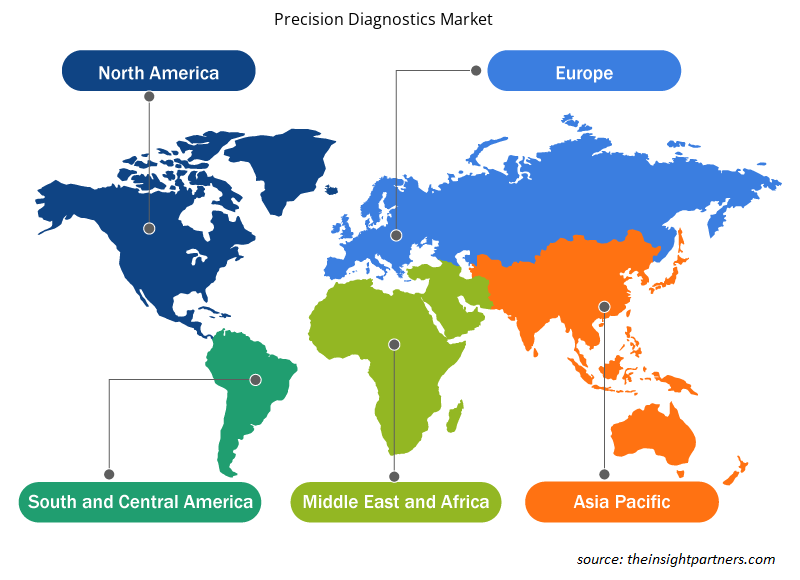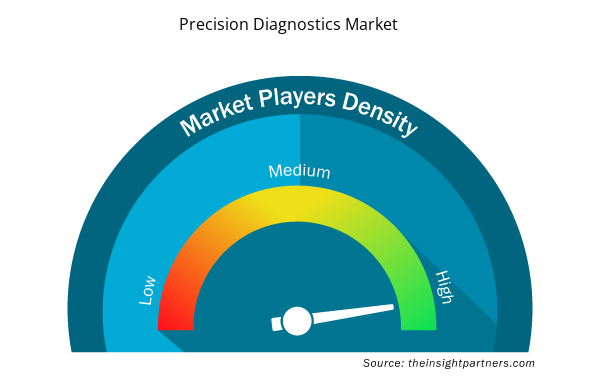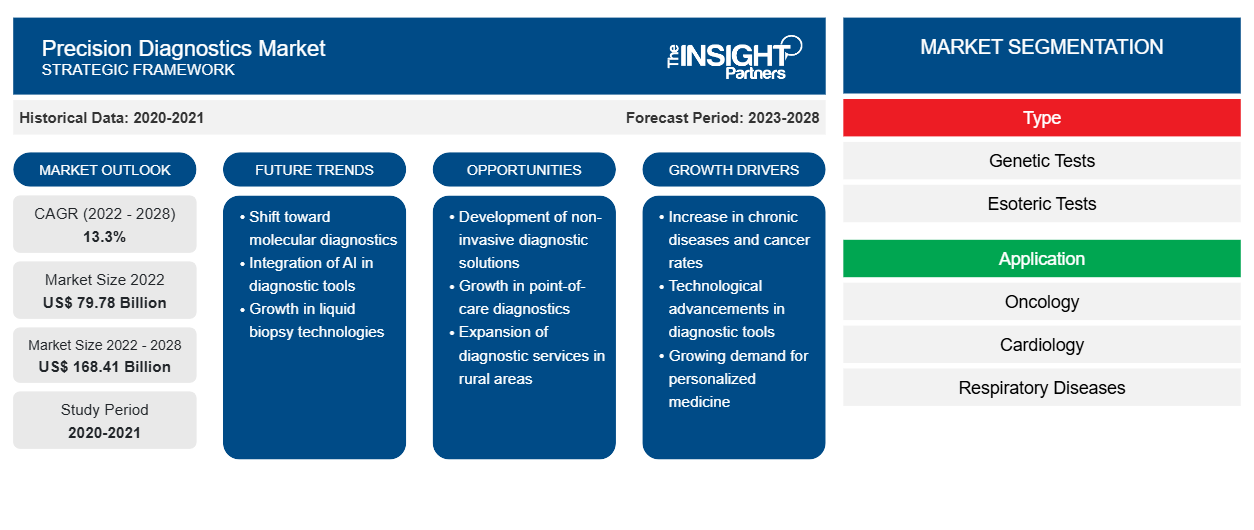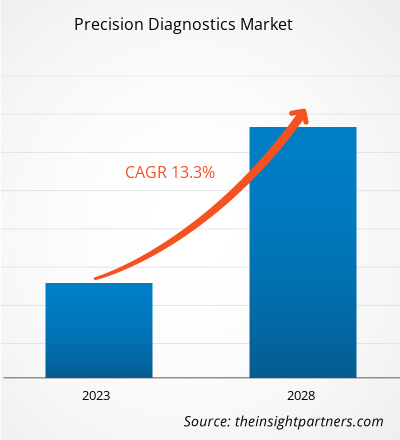[研究报告] 精准诊断市场规模预计将从 2022 年的 797.7688 亿美元增至 2028 年的 1684.0571 亿美元;预计2022 年至 2028 年的复合年增长率为 13.3%。
精准诊断是一种疾病诊断方法,可以详细而准确地解释患者的病情。它可以帮助医疗保健专业人员有效而高效地开展治疗程序。它用于通过各种测试(包括深奥的测试、基因测试等)来治疗糖尿病、癌症和其他疾病。
精密诊断市场根据类型、应用、最终用户和地理位置进行细分。按地理位置划分,市场分为北美、欧洲、亚太地区、中东和非洲以及 SAM。精密诊断市场报告提供了对市场的见解和深入分析,强调了市场规模、趋势、技术进步和市场动态等参数。它还提供了全球领先市场参与者的竞争格局分析。此外,该报告还包括 COVID-19 大流行对所有地区精密诊断市场的影响。
定制此报告以满足您的需求
您可以免费定制任何报告,包括本报告的部分内容、国家级分析、Excel 数据包,以及为初创企业和大学提供优惠和折扣
- 获取此报告的关键市场趋势。这个免费样品将包括数据分析,从市场趋势到估计和预测。
精准诊断市场的增长归因于开发新型癌症治疗方法的渠道研究数量不断增加,以及政府为提高社区卫生工作者对精准诊断的认识而采取的举措。然而,诊断和精准医疗的高成本限制了市场的增长。
市场洞察
肿瘤学和其他疾病领域的应用日益增多,推动精准诊断市场增长
精准医疗概念正在被大力应用于罕见病的治疗。尽管它在肿瘤学中更受欢迎,但它正逐渐传播到其他专业。癌症患病率的上升和罕见神经系统疾病发病率的上升,增加了对精准医疗的需求,从而推动了全球精准诊断市场的增长。此外,根据神经病学联盟的数据,2019 年登记的神经系统病例约为 1470 万例,至少每 6 人中就有 1 人患有一种或多种神经系统疾病。根据美国国家癌症研究所的数据,到 2040 年,新发癌症病例数预计将上升到 2950 万例,癌症相关死亡人数将增加 1640 万例。根据世界卫生组织 (WHO) 的数据,最常见的痴呆症形式阿尔茨海默病占痴呆症病例的近 60-70%。此外,截至 2021 年 9 月,全球有超过 5500 万人患有痴呆症,每年新增近 1000 万例。此外,对肿瘤学和其他疾病的治疗程序的需求不断增长,也推动了治疗程序的采用。
此外,生物制药公司之间越来越多的战略合作旨在根据特定需求开发针对特定患者群体的药物,并提供有效的治疗程序和服务,从而增加了临床试验的数量。例如,Personal Genome Diagnostics Inc. 和麻省总医院于 2021 年合作推进有效治疗服务的开发。2022 年 4 月,精准癌症联盟 ( PCC ) 成立,作为制药公司的新合作,其共同愿景是为全球所有癌症患者提供全面的检测。因此,肿瘤学和其他疾病领域的应用不断增长推动了精准诊断市场的增长。
基于类型的洞察
根据类型,精准诊断市场分为基因测试、深奥测试和其他。2022 年,基因测试部分占据市场的最大份额。此外,预计同一部分在预测期内的复合年增长率最高,为 13.8%。
基于应用的洞察
根据应用,精准诊断市场细分为肿瘤学、心脏病学、呼吸系统疾病、免疫学等。肿瘤学领域在 2022 年占据最大的市场份额。此外,预计同一领域在预测期内的复合年增长率最高,为 13.8%。
基于最终用户的洞察
根据最终用户,精准诊断市场分为临床实验室、医院、家庭护理和其他。临床实验室部门在 2022 年占据最大的市场份额。此外,预计同一部门在预测期内的复合年增长率最高,为 13.8%。
精准诊断市场参与者专注于采用有机战略,包括产品发布和扩张,以扩大其全球影响力和产品组合并满足日益增长的需求。
活动管理平台
精准诊断市场区域洞察
Insight Partners 的分析师已详尽解释了预测期内影响精准诊断市场的区域趋势和因素。本节还讨论了北美、欧洲、亚太地区、中东和非洲以及南美和中美洲的精准诊断市场细分和地理位置。

- 获取精准诊断市场的区域特定数据
精准诊断市场报告范围
| 报告属性 | 细节 |
|---|---|
| 2022 年市场规模 | 797.8亿美元 |
| 2028 年市场规模 | 1684.1亿美元 |
| 全球复合年增长率(2022 - 2028) | 13.3% |
| 史料 | 2020-2021 |
| 预测期 | 2023-2028 |
| 涵盖的领域 | 按类型
|
| 覆盖地区和国家 | 北美
|
| 市场领导者和主要公司简介 |
|
精准诊断市场参与者密度:了解其对业务动态的影响
精准诊断市场正在快速增长,这得益于终端用户需求的不断增长,而这些需求又源于消费者偏好的不断变化、技术进步以及对产品优势的认识不断提高等因素。随着需求的增加,企业正在扩大其产品范围,进行创新以满足消费者的需求,并利用新兴趋势,从而进一步推动市场增长。
市场参与者密度是指在特定市场或行业内运营的企业或公司的分布情况。它表明在给定市场空间中,相对于其规模或总市场价值,有多少竞争对手(市场参与者)存在。
精准诊断市场的主要公司有:
- Quest Diagnostics 公司
- 凯杰公司
- 瑞士精密诊断有限公司
- 荷兰皇家飞利浦公司
- Lantheus 医学成像公司
免责声明:上面列出的公司没有按照任何特定顺序排列。

- 了解精准诊断市场主要参与者概况
按地理位置
根据地域划分,精准诊断市场分为北美(美国、加拿大和墨西哥)、欧洲(英国、德国、法国、意大利、西班牙和欧洲其他地区)、亚太地区(中国、日本、印度、澳大利亚、韩国和亚太其他地区)、中东和非洲(阿联酋、沙特阿拉伯、南非和中东和非洲其他地区)以及南美洲和中美洲(巴西、阿根廷和南美洲和中美洲其他地区)。
公司简介
- Quest Diagnostics 公司
- 凯杰公司
- 瑞士精密诊断有限公司
- 荷兰皇家飞利浦公司
- Lantheus 医学成像公司
- 西门子医疗股份公司
- 雅培
- 诺华公司
- 赛诺菲
- 拜耳公司
- 历史分析(2 年)、基准年、预测(7 年)及复合年增长率
- PEST 和 SWOT 分析
- 市场规模价值/数量 - 全球、区域、国家
- 行业和竞争格局
- Excel 数据集


- Water Pipeline Leak Detection System Market
- Social Employee Recognition System Market
- Educational Furniture Market
- Batter and Breader Premixes Market
- Fill Finish Manufacturing Market
- Precast Concrete Market
- Compounding Pharmacies Market
- Greens Powder Market
- Occupational Health Market
- Collagen Peptides Market

Report Coverage
Revenue forecast, Company Analysis, Industry landscape, Growth factors, and Trends

Segment Covered
This text is related
to segments covered.

Regional Scope
North America, Europe, Asia Pacific, Middle East & Africa, South & Central America

Country Scope
This text is related
to country scope.
常见问题
Precision diagnostics are disease diagnosis methods that explain the patient’s condition in a detailed and precise manner. It helps healthcare professionals to carry out treatment procedures in an effective and efficient manner. It is used to cure diabetes, cancer, and other disorders using various diagnostics tests.
The factors that are driving the growth of market are increasing demands of precision medicines and rising application of precision diagnostics. However, high investments involved in the R&D of precision medicine and diagnostic kits is the major factor hindering the precision diagnostics market growth.
The precision diagnostics market majorly consists of the players, such as Quest Diagnostics Incorporated; QIAGEN; Swiss Precision Diagnostics GmbH; Koninklijke Philips N.V.; Lantheus Medical Imaging, Inc.; Siemens Healthineers AG; Abbott; Novartis AG; Sanofi; and Bayer AG.
The market is estimated to grow at a CAGR of 13.3% during the forecast period.
The precision diagnostics market is estimated to be valued at US$ 79,776.88 million in 2022.
The precision diagnostics market is expected to be valued at US$ 168,405.71 million in 2028.
North America accounts for the major market share of precision diagnostics market in 2022 due to increasing prevalence of cancer and chronic cases in the region and increasing initiatives by government and companies operating in the country.
The colorectal cancer market is analyzed in the basis of type, application, and end user. Based on type, the market is segmented into genetic tests, esoteric tests, and others. The genetic tests segment held the largest share of the market. Moreover, the same segment is anticipated to register the highest CAGR in the forecast period.
Asia Pacific is expected to be the fastest growing region in precision diagnostics market over the forecast period due to developing healthcare infrastructure, enormous population base, growing prevalence of chronic diseases, growing government efforts, and technological improvement in the sector.
Trends and growth analysis reports related to Life Sciences : READ MORE..
The List of Companies - Precision Diagnostics Market
- Quest Diagnostics Incorporated
- QIAGEN
- Swiss Precision Diagnostics GmbH
- Koninklijke Philips N.V.
- Lantheus Medical Imaging, Inc.
- Siemens Healthineers AG
- Abbott
- Novartis AG
- Sanofi
- Bayer AG
The Insight Partners performs research in 4 major stages: Data Collection & Secondary Research, Primary Research, Data Analysis and Data Triangulation & Final Review.
- Data Collection and Secondary Research:
As a market research and consulting firm operating from a decade, we have published and advised several client across the globe. First step for any study will start with an assessment of currently available data and insights from existing reports. Further, historical and current market information is collected from Investor Presentations, Annual Reports, SEC Filings, etc., and other information related to company’s performance and market positioning are gathered from Paid Databases (Factiva, Hoovers, and Reuters) and various other publications available in public domain.
Several associations trade associates, technical forums, institutes, societies and organization are accessed to gain technical as well as market related insights through their publications such as research papers, blogs and press releases related to the studies are referred to get cues about the market. Further, white papers, journals, magazines, and other news articles published in last 3 years are scrutinized and analyzed to understand the current market trends.
- Primary Research:
The primarily interview analysis comprise of data obtained from industry participants interview and answers to survey questions gathered by in-house primary team.
For primary research, interviews are conducted with industry experts/CEOs/Marketing Managers/VPs/Subject Matter Experts from both demand and supply side to get a 360-degree view of the market. The primary team conducts several interviews based on the complexity of the markets to understand the various market trends and dynamics which makes research more credible and precise.
A typical research interview fulfils the following functions:
- Provides first-hand information on the market size, market trends, growth trends, competitive landscape, and outlook
- Validates and strengthens in-house secondary research findings
- Develops the analysis team’s expertise and market understanding
Primary research involves email interactions and telephone interviews for each market, category, segment, and sub-segment across geographies. The participants who typically take part in such a process include, but are not limited to:
- Industry participants: VPs, business development managers, market intelligence managers and national sales managers
- Outside experts: Valuation experts, research analysts and key opinion leaders specializing in the electronics and semiconductor industry.
Below is the breakup of our primary respondents by company, designation, and region:

Once we receive the confirmation from primary research sources or primary respondents, we finalize the base year market estimation and forecast the data as per the macroeconomic and microeconomic factors assessed during data collection.
- Data Analysis:
Once data is validated through both secondary as well as primary respondents, we finalize the market estimations by hypothesis formulation and factor analysis at regional and country level.
- Macro-Economic Factor Analysis:
We analyse macroeconomic indicators such the gross domestic product (GDP), increase in the demand for goods and services across industries, technological advancement, regional economic growth, governmental policies, the influence of COVID-19, PEST analysis, and other aspects. This analysis aids in setting benchmarks for various nations/regions and approximating market splits. Additionally, the general trend of the aforementioned components aid in determining the market's development possibilities.
- Country Level Data:
Various factors that are especially aligned to the country are taken into account to determine the market size for a certain area and country, including the presence of vendors, such as headquarters and offices, the country's GDP, demand patterns, and industry growth. To comprehend the market dynamics for the nation, a number of growth variables, inhibitors, application areas, and current market trends are researched. The aforementioned elements aid in determining the country's overall market's growth potential.
- Company Profile:
The “Table of Contents” is formulated by listing and analyzing more than 25 - 30 companies operating in the market ecosystem across geographies. However, we profile only 10 companies as a standard practice in our syndicate reports. These 10 companies comprise leading, emerging, and regional players. Nonetheless, our analysis is not restricted to the 10 listed companies, we also analyze other companies present in the market to develop a holistic view and understand the prevailing trends. The “Company Profiles” section in the report covers key facts, business description, products & services, financial information, SWOT analysis, and key developments. The financial information presented is extracted from the annual reports and official documents of the publicly listed companies. Upon collecting the information for the sections of respective companies, we verify them via various primary sources and then compile the data in respective company profiles. The company level information helps us in deriving the base number as well as in forecasting the market size.
- Developing Base Number:
Aggregation of sales statistics (2020-2022) and macro-economic factor, and other secondary and primary research insights are utilized to arrive at base number and related market shares for 2022. The data gaps are identified in this step and relevant market data is analyzed, collected from paid primary interviews or databases. On finalizing the base year market size, forecasts are developed on the basis of macro-economic, industry and market growth factors and company level analysis.
- Data Triangulation and Final Review:
The market findings and base year market size calculations are validated from supply as well as demand side. Demand side validations are based on macro-economic factor analysis and benchmarks for respective regions and countries. In case of supply side validations, revenues of major companies are estimated (in case not available) based on industry benchmark, approximate number of employees, product portfolio, and primary interviews revenues are gathered. Further revenue from target product/service segment is assessed to avoid overshooting of market statistics. In case of heavy deviations between supply and demand side values, all thes steps are repeated to achieve synchronization.
We follow an iterative model, wherein we share our research findings with Subject Matter Experts (SME’s) and Key Opinion Leaders (KOLs) until consensus view of the market is not formulated – this model negates any drastic deviation in the opinions of experts. Only validated and universally acceptable research findings are quoted in our reports.
We have important check points that we use to validate our research findings – which we call – data triangulation, where we validate the information, we generate from secondary sources with primary interviews and then we re-validate with our internal data bases and Subject matter experts. This comprehensive model enables us to deliver high quality, reliable data in shortest possible time.


 获取此报告的免费样本
获取此报告的免费样本